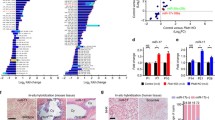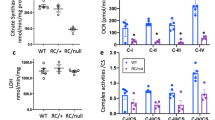Abstract
Adult autosomal dominant polycystic kidney disease (ADPKD) has been shown to be related as a “third hit” to the occurrence of acute or chronic kidney injury. Here, we examined whether dehydration, as a common kidney risk factor, could cause cystogenesis in chronic-onset Pkd1−/− mice by regulating macrophage activation. First, we confirmed that dehydration accelerated cytogenesis in Pkd1−/− mice and that macrophages infiltrated the kidney tissues even earlier than macroscopic cyst formation. Then, microarray analysis suggested that glycolysis pathway may be involved in macrophage activation in Pkd1−/− kidneys under conditions of dehydration. Further, we confirmed glycolysis pathway was activated and lactic acid (L-LA) was overproduced in the Pkd1−/− kidney under conditions of dehydration. We have already proved that L-LA strongly stimulated M2 macrophage polarization and overproduction of polyamine in macrophage in vitro, and in the present study, we further discovered that M2 polarization-induced polyamine production shortened the primary cilia length by disrupting the PC1/PC2 complex. Finally, the activation of L-LA–arginase 1–polyamine pathway contributed to cystogenesis and progressive cyst growth in Pkd1−/− mice recurrently exposed to dehydration.







Similar content being viewed by others
Availability of Data and Materials
Microarray data have been deposited in the Array Express database at EMBL-EBI (www.ebi.ac.uk/arrayexpress) under the accession number E-MTAB-10449.
References
Ong, A.C., O. Devuyst, B. Knebelmann, and G. Walz. 2015. Autosomal dominant polycystic kidney disease: The changing face of clinical management. Lancet 385 (9981): 1993–2002. https://doi.org/10.1016/s0140-6736(15)60907-2.
Spithoven, E.M., A. Kramer, E. Meijer, B. Orskov, C. Wanner, J.M. Abad, N. Aresté, R.A. de la Torre, F. Caskey, C. Couchoud, et al. 2014. Renal replacement therapy for autosomal dominant polycystic kidney disease (ADPKD) in Europe: prevalence and survival—an analysis of data from the ERA-EDTA Registry. Nephrology Dialysis Transplantation 29: Suppl 4 iv15–25. https://doi.org/10.1093/ndt/gfu017
Torres, V.E., A.B. Chapman, O. Devuyst, R.T. Gansevoort, J.J. Grantham, E. Higashihara, R.D. Perrone, H.B. Krasa, J. Ouyang, and F.S. Czerwiec. 2012. Tolvaptan in patients with autosomal dominant polycystic kidney disease. New England Journal of Medicine 367 (25): 2407–2418. https://doi.org/10.1056/NEJMoa1205511.
Blair, H.A., and G.M. Keating. 2015. Tolvaptan: A review in autosomal dominant polycystic kidney disease. Drugs 75 (15): 1797–1806. https://doi.org/10.1007/s40265-015-0475-x.
Wang, A., T. Hirose, Y. Ohsaki, C. Takahashi, E. Sato, I. Oba-Yabana, S. Kinugasa, Y. Muroya, S. Ito, and T. Mori. 2019. Hydrochlorothiazide ameliorates polyuria caused by tolvaptan treatment of polycystic kidney disease in PCK rats. Clinical and Experimental Nephrology 23 (4): 455–464. https://doi.org/10.1007/s10157-018-1669-9.
Khan, M.Y., M.S. Rawala, M. Siddiqui, W. Abid, and A. Aslam. 2019. Tolvaptan-induced liver injury: who is at risk? A case report and literature review. Cureus 11 (6): e4842. https://doi.org/10.7759/cureus.4842
Li, X., B.S. Magenheimer, S. Xia, T. Johnson, D.P. Wallace, J.P. Calvet, and R. Li. 2008. A tumor necrosis factor-alpha-mediated pathway promoting autosomal dominant polycystic kidney disease. Nature Medicine 14 (8): 863–868. https://doi.org/10.1038/nm1783.
Swenson-Fields, K.I., C.J. Vivian, S.M. Salah, J.D. Peda, B.M. Davis, N. van Rooijen, D.P. Wallace, and T.A. Fields. 2013. Macrophages promote polycystic kidney disease progression. Kidney International 83 (5): 855–864. https://doi.org/10.1038/ki.2012.446.
Chen, L., X. Zhou, L.X. Fan, Y. Yao, K.I. Swenson-Fields, M. Gadjeva, D.P. Wallace, D.J. Peters, A. Yu, J.J. Grantham, et al. 2015. Macrophage migration inhibitory factor promotes cyst growth in polycystic kidney disease. The Journal of Clinical Investigation. https://doi.org/10.1172/jci80467.
Yang, Y., M. Chen, J. Zhou, J. Lv, S. Song, L. Fu, J. Chen, M. Yang, and C. Mei. 2018. Interactions between macrophages and cyst-lining epithelial cells promote kidney cyst growth in Pkd1-deficient mice. Journal of the American Society of Nephrology 29 (9): 2310–2325. https://doi.org/10.1681/asn.2018010074.
Takakura, A., L. Contrino, X. Zhou, J.V. Bonventre, Y. Sun, B.D. Humphreys, and J. Zhou. 2009. Renal injury is a third hit promoting rapid development of adult polycystic kidney disease. Human Molecular Genetics 18 (14): 2523–2531. https://doi.org/10.1093/hmg/ddp147.
Belliere, J., A. Casemayou, L. Ducasse, A. Zakaroff-Girard, F. Martins, J.S. Iacovoni, C. Guilbeau-Frugier, B. Buffin-Meyer, B. Pipy, D. Chauveau, et al. 2015. Specific macrophage subtypes influence the progression of rhabdomyolysis-induced kidney injury. Journal of the American Society of Nephrology 26 (6): 1363–1377. https://doi.org/10.1681/asn.2014040320.
García-Trabanino, R., E. Jarquín, C. Wesseling, R.J. Johnson, M. González-Quiroz, I. Weiss, J. Glaser, J. José Vindell, L. Stockfelt, C. Roncal, et al. 2015. Heat stress, dehydration, and kidney function in sugarcane cutters in El Salvador—a cross-shift study of workers at risk of Mesoamerican nephropathy. Environmental Research 142: 746–755. https://doi.org/10.1016/j.envres.2015.07.007.
Wesseling, C., A. Aragón, M. González, I. Weiss, J. Glaser, C.J. Rivard, C. Roncal-Jiménez, R. Correa-Rotter, and R.J. Johnson. 2016. Heat stress, hydration and uric acid: a cross-sectional study in workers of three occupations in a hotspot of Mesoamerican nephropathy in Nicaragua. BMJ Open 6 (12): e011034. https://doi.org/10.1136/bmjopen-2016-011034
Correa-Rotter, R., and R. García-Trabanino. 2019. Mesoamerican nephropathy. Seminars in Nephrology 39 (3): 263–271. https://doi.org/10.1016/j.semnephrol.2019.02.004.
Roncal Jimenez, C.A., T. Ishimoto, M.A. Lanaspa, C.J. Rivard, T. Nakagawa, A.A. Ejaz, C. Cicerchi, S. Inaba, M. Le, M. Miyazaki, et al. 2014. Fructokinase activity mediates dehydration-induced renal injury. Kidney International 86 (2): 294–302. https://doi.org/10.1038/ki.2013.492.
Piontek, K., L.F. Menezes, M.A. Garcia-Gonzalez, D.L. Huso, and G.G. Germino. 2007. A critical developmental switch defines the kinetics of kidney cyst formation after loss of Pkd1. Nature Medicine 13 (12): 1490–1495. https://doi.org/10.1038/nm1675.
Wu, M., M. Chen, Y. Jing, J. Gu, S. Mei, Q. Yao, J. Zhou, M. Yang, L. Sun, W. Wang, et al. 2016. The C-terminal tail of polycystin-1 regulates complement factor B expression by signal transducer and activator of transcription 1. American Journal of Physiology. Renal Physiology 310 (11): F1284-1294. https://doi.org/10.1152/ajprenal.00428.2015.
Raphael, K.L., K.A. Strait, P.K. Stricklett, R.L. Miller, R.D. Nelson, K.B. Piontek, G.G. Germino, and D.E. Kohan. 2009. Inactivation of Pkd1 in principal cells causes a more severe cystic kidney disease than in intercalated cells. Kidney International 75 (6): 626–633. https://doi.org/10.1038/ki.2008.659.
Buchholz, B., and K.U. Eckardt. 2020. Role of oxygen and the HIF-pathway in polycystic kidney disease. Cellular Signalling 69: 109524. https://doi.org/10.1016/j.cellsig.2020.109524
Yang, Y., L. Ma, M. Song, X. Li, F. He, C. Wang, M. Chen, J. Zhou, and C. Mei. 2020. The role of the complement factor B-arginase-polyamine molecular axis in uremia-induced cardiac remodeling in mice. European Journal of Immunology 50 (2): 220–233. https://doi.org/10.1002/eji.201948227.
Zhang, Y., E.A. Daniel, J. Metcalf, Y. Dai, G.A. Reif, and D.P. Wallace. 2022. CaMK4 overexpression in polycystic kidney disease promotes mTOR-mediated cell proliferation. Journal of Molecular Cell Biology 14 (7). https://doi.org/10.1093/jmcb/mjac050
Yuajit, C., C. Muanprasat, A.R. Gallagher, S.V. Fedeles, S. Kittayaruksakul, S. Homvisasevongsa, S. Somlo, and V. Chatsudthipong. 2014. Steviol retards renal cyst growth through reduction of CFTR expression and inhibition of epithelial cell proliferation in a mouse model of polycystic kidney disease. Biochemical Pharmacology 88 (3): 412–421. https://doi.org/10.1016/j.bcp.2014.01.038.
Hopp, K., C.J. Ward, C.J. Hommerding, S.H. Nasr, H.F. Tuan, V.G. Gainullin, S. Rossetti, V.E. Torres, and P.C. Harris. 2012. Functional polycystin-1 dosage governs autosomal dominant polycystic kidney disease severity. The Journal of Clinical Investigation 122 (11): 4257–4273. https://doi.org/10.1172/jci64313.
Leonhard, W.N., H. Happe, and D.J. Peters. 2016. Variable cyst development in autosomal dominant polycystic kidney disease: The biologic context. Journal of the American Society of Nephrology 27 (12): 3530–3538. https://doi.org/10.1681/asn.2016040425.
Happé H, Leonhard WN, van der Wal A, van de Water B, Lantinga-van Leeuwen IS, Breuning MH, de Heer E, Peters DJ. 2009. Toxic tubular injury in kidneys from Pkd1-deletion mice accelerates cystogenesis accompanied by dysregulated planar cell polarity and canonical Wnt signaling pathways. Human Molecular Genetics 18 (14): 2532–2542. https://doi.org/10.1093/hmg/ddp190.
Legué, E., and K.F. Liem Jr. 2019. Tulp3 is a ciliary trafficking gene that regulates polycystic kidney disease. Current Biology 29 (5): 803-812.e805. https://doi.org/10.1016/j.cub.2019.01.054.
Nowak, K.L., and K. Hopp. 2020. Metabolic reprogramming in autosomal dominant polycystic kidney disease: Evidence and therapeutic potential. Clinical Journal of the American Society of Nephrology 15 (4): 577–584. https://doi.org/10.2215/cjn.13291019.
Rowe, I., M. Chiaravalli, V. Mannella, V. Ulisse, G. Quilici, M. Pema, X.W. Song, H. Xu, S. Mari, F. Qian, et al. 2013. Defective glucose metabolism in polycystic kidney disease identifies a new therapeutic strategy. Nature Medicine 19 (4): 488–493. https://doi.org/10.1038/nm.3092.
Chiaravalli, M., I. Rowe, V. Mannella, G. Quilici, T. Canu, V. Bianchi, A. Gurgone, S. Antunes, P. D’Adamo, A. Esposito, et al. 2016. 2-Deoxy-d-glucose ameliorates PKD progression. Journal of the American Society of Nephrology 27 (7): 1958–1969. https://doi.org/10.1681/asn.2015030231.
Gray, L.R., S.C. Tompkins, and E.B. Taylor. 2014. Regulation of pyruvate metabolism and human disease. Cellular and Molecular Life Sciences 71 (14): 2577–2604. https://doi.org/10.1007/s00018-013-1539-2.
Hopp, K., E.K. Kleczko, B.Y. Gitomer, M. Chonchol, J. Klawitter, U. Christians, and J. Klawitter. 2022. Metabolic reprogramming in a slowly developing orthologous model of polycystic kidney disease. American Journal of Physiology. Renal Physiology 322 (3): F258-f267. https://doi.org/10.1152/ajprenal.00262.2021.
Trott, J.F., V.J. Hwang, T. Ishimaru, K.J. Chmiel, J.X. Zhou, K. Shim, B.J. Stewart, M.R. Mahjoub, K.Y. Jen, D.K. Barupal, et al. 2018. Arginine reprogramming in ADPKD results in arginine-dependent cystogenesis. American Journal of Physiology. Renal Physiology 315 (6): F1855-f1868. https://doi.org/10.1152/ajprenal.00025.2018.
Rojas-Martínez, C., R.I. Rodríguez-Vivas, J.V. Figueroa Millán, K.Y. Acosta Viana, E.J. Gutiérrez Ruiz, and J.A. Álvarez Martínez. 2017. Putrescine: Essential factor for in vitro proliferation of Babesia bovis. Experimental Parasitology 175: 79–84. https://doi.org/10.1016/j.exppara.2017.01.010.
Wang, S., and Z. Dong. 2013. Primary cilia and kidney injury: Current research status and future perspectives. American Journal of Physiology. Renal Physiology 305 (8): F1085-1098. https://doi.org/10.1152/ajprenal.00399.2013.
Cantagrel, V., J.L. Silhavy, S.L. Bielas, D. Swistun, S.E. Marsh, J.Y. Bertrand, S. Audollent, T. Attié-Bitach, K.R. Holden, W.B. Dobyns, et al. 2008. Mutations in the cilia gene ARL13B lead to the classical form of Joubert syndrome. American Journal of Human Genetics 83 (2): 170–179. https://doi.org/10.1016/j.ajhg.2008.06.023.
Duldulao, N.A., S. Lee, and Z. Sun. 2009. Cilia localization is essential for in vivo functions of the Joubert syndrome protein Arl13b/scorpion. Development 136 (23): 4033–4042. https://doi.org/10.1242/dev.036350.
Dustin, M.L., M.W. Olszowy, A.D. Holdorf, J. Li, S. Bromley, N. Desai, P. Widder, F. Rosenberger, P.A. van der Merwe, P.M. Allen, et al. 1998. A novel adaptor protein orchestrates receptor patterning and cytoskeletal polarity in T-cell contacts. Cell 94 (5): 667–677. https://doi.org/10.1016/s0092-8674(00)81608-6.
Tolvanen, T.A., S.N. Dash, Z. Polianskyte-Prause, V. Dumont, and S. Lehtonen. 2015. Lack of CD2AP disrupts Glut4 trafficking and attenuates glucose uptake in podocytes. Journal of Cell Science 128 (24): 4588–4600. https://doi.org/10.1242/jcs.175075.
Sever, S., and J. Reiser. 2015. CD2AP, dendrin, and cathepsin L in the kidney. American Journal of Pathology 185 (11): 3129–3130. https://doi.org/10.1016/j.ajpath.2015.06.022.
Funding
The present work was supported by the following grants: (1) The National Natural Science Foundation of China (81700579, 81670612); (2) The Three-year Project of Action for Shanghai Public Health System (GWIV‒18); (3) The National Key Research and Development Program of China (2016YFC0901502); (4) Shanghai Top Priority Key Clinical Disciplines Construction Project (2017ZZ02009); and (5) the 13th Five-Year Key Plan for the Military Medical Scientific Research Project (CBJ14L016). No authors have any financial conflicts of interest.
Author information
Authors and Affiliations
Contributions
Yang Yang and Changlin Mei designed the study; Yang Yang, Jie Zhou, Dongjuan Zhang, Jiayi Lv, Meihan Chen, Chao Wang, Minghui Song, Fagui He, and Shuwei Song carried out experiments; Yang Yang, Dongjuan Zhang, and Chao Wang analyzed the data; Yang Yang, Dongjuan Zhang, and Fagui He made the figures; Yang Yang drafted the paper; all authors approved the final version of the manuscript.
Corresponding authors
Ethics declarations
Competing Interests
The authors declare no competing interests.
Additional information
Publisher's Note
Springer Nature remains neutral with regard to jurisdictional claims in published maps and institutional affiliations.
Supplementary Information
Below is the link to the electronic supplementary material.
Rights and permissions
Springer Nature or its licensor (e.g. a society or other partner) holds exclusive rights to this article under a publishing agreement with the author(s) or other rightsholder(s); author self-archiving of the accepted manuscript version of this article is solely governed by the terms of such publishing agreement and applicable law.
About this article
Cite this article
Yang, Y., Zhou, J., Zhang, D. et al. Dehydration Accelerates Cytogenesis and Cyst Growth in Pkd1−/− Mice by Regulating Macrophage M2 Polarization. Inflammation 46, 1272–1289 (2023). https://doi.org/10.1007/s10753-023-01806-5
Received:
Revised:
Accepted:
Published:
Issue Date:
DOI: https://doi.org/10.1007/s10753-023-01806-5




